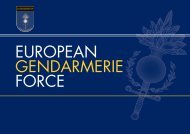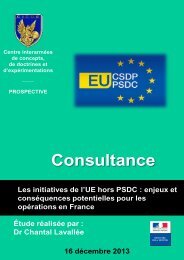Conference
science-research-bulletin-2013-conference
science-research-bulletin-2013-conference
Create successful ePaper yourself
Turn your PDF publications into a flip-book with our unique Google optimized e-Paper software.
EUROPEAN POLICE SCIENCE AND RESEARCH BULLETIN<br />
SPECIAL CONFERENCE EDITION<br />
INTRODUCTION — ROMA<br />
COMMUNITIES IN SLOVENIA<br />
Policing in diverse, multicultural communities<br />
presents challenges for contemporary policing.<br />
Historically and currently, the interactions<br />
between police and multicultural communities<br />
are often tense due to language barriers, cultural<br />
misperceptions on both sides, fear of outside<br />
authority figures on the part of marginalised<br />
groups etc. This is the case also with the Roma,<br />
Europe’s largest minority. Roma were and are a<br />
target of persistent persecution from each and<br />
every power in history and even in the present<br />
times, not only in countries that lack democratic<br />
tradition, but also in countries which consider<br />
themselves cradles of democracy. Brearley<br />
(2001) excellently summarises the position of<br />
Roma in Europe in recent centuries:<br />
‘Roma/Gypsies, nomads newly arrived in Europe<br />
in the 1400s, endured expulsions, forcible<br />
removal of children, servitude in galleys or<br />
mines, death sentences for being Gypsy, and<br />
absolute slavery in the Balkans from the 16th<br />
century onward. Persecution stemmed from<br />
the highest authorities in State and Church.<br />
Following the murder of 200 000 to 500 000<br />
Roma in the Holocaust, persecution persists,<br />
especially in Central and Eastern Europe where<br />
Roma form up to 10 % of the population<br />
(Bulgaria, Slovakia, Romania). Discriminated<br />
against under communism, their plight has<br />
dramatically worsened since 1989. Endemic<br />
problems (low life expectancy, high illiteracy,<br />
dire poverty, poor housing) are now heightened<br />
by massive, disproportionate unemployment.<br />
Unprecedented persecution has been<br />
unleashed by new state nationalism and easing<br />
of censorship. Roma are the new scapegoat<br />
for post-Communist society’s ills. The media<br />
commonly stigmatise Roma.’ (Lobnikar, Hozjan,<br />
Šuklje & Banutai, 2013).<br />
The Roma population originally comes from India.<br />
They started leaving India in 1192 (Djurić & Horvat<br />
Muc, 2010). Their nomadic lifestyle brought them<br />
through Afghanistan and Iran, to Turkey, Greece<br />
and toward Central Europe, while another part<br />
of the Roma population went through Egypt<br />
all the way to Spain (Horvat Muc, 2011; Novak,<br />
2012a). The first record of the Roma people in<br />
Slovenia goes back to the 14th century. The fact<br />
that the official number of Roma living in Slovenia<br />
is different than the actual number is one of the<br />
many challenges of current Roma issues. Statistics<br />
show that approximately 3 200 Roma people live<br />
in Slovenia. But the actual number varies between<br />
11 000 and 12 000 (Banutai, Strobl, Haberfeld<br />
& Duque, 2011). These discrepancies occur<br />
due to many different factors, one of which<br />
is the disarray of the Roma settlements. Few<br />
settlements are legalised and houses are often<br />
not numbered; therefore, many Roma people<br />
can share a household with other Roma families.<br />
There are four groups within the Roma<br />
population in Slovenia (Štrukelj, 2004): the Roma<br />
community in the Dolenjska region, Maribor,<br />
Gorenjska region, and Prekmurje region. Roma<br />
primarily live in one of the 130 settlements in<br />
the country, one-third of which are illegal by<br />
virtue of resting on private or municipal land.<br />
The Roma community in the Dolenjska region<br />
came from Bosnia and Herzegovina and Croatia.<br />
By occupation they were mainly horse breeders<br />
and blacksmiths (Štrukelj, 2004). This group<br />
of the Roma community is probably the least<br />
integrated into the majority population. Thus<br />
general security issues as well as differences and<br />
disagreements exist between the Roma and<br />
the larger community. The Roma community<br />
in Maribor came from Kosovo and the Republic<br />
of Macedonia and their religious orientation<br />
is Muslim. By occupation they were mainly<br />
tradesmen in different areas and they are very<br />
adaptable and competitive (Novak, 2012a).<br />
They are almost completely integrated into the<br />
population — the reason being that they did not<br />
have a chance to move together and create a so<br />
called ’ghetto’ as the Roma in the Dolenjska and<br />
Prekmurje regions did (Novak, 2012a) — local<br />
authorities in Maribor always wanted them to<br />
live within city limits. The Roma in Gorenjska<br />
region — also called Sinti — came from the<br />
North, the territory of the former Habsburg<br />
monarchy. They are completely integrated into<br />
the population and do not live in closed societies<br />
and settlements (Novak, 2012a).<br />
The Roma population in Prekmurje arrived from<br />
Hungary and Austria. By occupation they were<br />
mainly musicians and farmers and were also<br />
very keen horsemen (Štrukelj, 2004; Horvat<br />
Muc, 2011). They speak a different Romani<br />
dialect than the Roma people in Dolenjska and<br />
Maribor (sometimes these groups do not even<br />
understand each other).<br />
64





